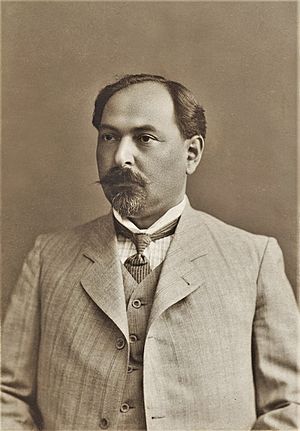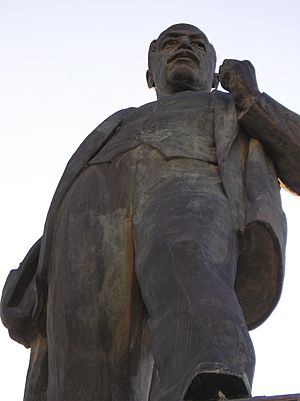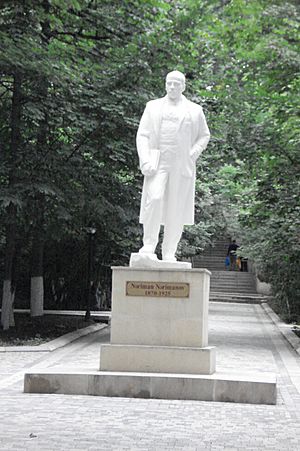Nariman Narimanov facts for kids
Quick facts for kids
Nariman Narimanov
Nəriman Nərimanov |
|
|---|---|

Narimanov in 1913
|
|
| Minister of Foreign Affairs of Azerbaijan SSR | |
| In office May 1920 – 2 May 1921 |
|
| President | Grigory Kaminsky (First Secretary of Azerbaijan Communist Party) |
| Preceded by | Fatali Khan Khoyski (ADR) |
| Succeeded by | Mirza Davud Huseynov |
| Chairmen of the Council of People's Commissars | |
| In office May 1921 – April 1922 |
|
| Preceded by | Office created |
| Succeeded by | Gazanfar Musabekov |
| Personal details | |
| Born | 14 April [O.S. 2 April] 1870 Tiflis, Russian Empire |
| Died | 19 March 1925 (aged 54) Moscow, Russian SFSR, Soviet Union |
| Resting place | Kremlin Wall Necropolis, Mosocw |
| Political party | RSDLP (Bolsheviks) (1905–1918) CPSU (1918–1925) |
| Signature |  |
Nariman Karbalayi Najaf oghlu Narimanov (Azerbaijani: Nəriman Kərbəlayi Nəcəf oğlu Nərimanov; 14 April 1870 – 19 March 1925) was an Azerbaijani revolutionary, writer, and politician. He was a member of the Bolshevik party. For about a year, starting in May 1920, Narimanov led the government of Soviet Azerbaijan. He later became a chairman of the Transcaucasian SFSR. He was also a Party Chairman of the Central Executive Committee of the Soviet Union from December 1922 until his death.
Narimanov was also a talented writer. He translated a famous play, The Government Inspector, into Turkic. He wrote many plays, stories, and novels himself. One of his well-known works is Bahadur and Sona (1896). He also wrote a historical story series called Nadir-Shah (1899).
Today, many places are named after him. These include a main district and a busy metro station in Baku. Many streets, parks, and halls across Azerbaijan also carry his name. The Azerbaijan Medical University is named after him too. In the Lankaran region, there is a town called Narimanabad. Other towns in countries that were once part of the Soviet Union, especially in Russia, are also named in his honor.
Contents
Narimanov's Early Life and Education
Nariman Narimanov was born on 14 April 1870. His birthplace was Tiflis, which is now Georgia. At that time, it was part of the Russian Empire. His family was Azerbaijani and belonged to the middle class. They were merchants.
Because his family had some money, Narimanov could go to school. He attended the Gori Teachers Seminary and graduated from there. Later, he studied medicine at Odessa University. He finished his medical studies in 1908.
As a young man, Narimanov became known as a writer in Azerbaijan. This was even before the Russian Revolution of 1905. He wrote novels that encouraged people to let go of old traditions and religious beliefs. At the same time, he worked as a teacher. He taught in a village called Gizel-Adjal, in the Tiflis Province. There, he saw how hard life was for the local farmers.
Narimanov's Political Journey

During the 1905 Revolution, Narimanov joined the Bolshevik party. He was very active and led student protests in Odessa. Later, he helped organize the Social Democratic Party. Because of these activities, he was arrested in 1909. He was then sent away for five years to Astrakhan.
After the October Revolution in 1917, Narimanov became the chairman of the Azerbaijani social democratic party, Hummet. This party was a early version of the Communist Party of Azerbaijan. He was appointed as a "People's Commissar of National Economy" by the Baku Soviet. This meant he was in charge of the economy.
When the Baku Soviet fell, Narimanov managed to escape to Astrakhan. This saved him from the sad fate of the 26 Baku Commissars. In Astrakhan, he became the head of the Near East Division. This was part of the People's Commissariat of Foreign Affairs of Soviet Russia. Later, he became a deputy in the Commissariat of National Affairs.
Narimanov believed that different groups should have some self-rule. This would be within a larger Soviet system. He played a key role in a decision in July 1919. This decision recognized Azerbaijan as an independent Soviet Republic.
In 1920, Narimanov was chosen to lead the Azerbaijani Revolutionary Committee. Soon after, he became the Chairman of the Council of People's Commissars. This made him the head of the Azerbaijani Soviet Republic's government. In 1922, he took part in the Genoese Conference as a member of the Soviet team. Later that year, he was elected chairman of the Union Council of the Transcaucasian Federation. On 30 December 1922, he became one of the four chairpersons of the Central Executive Committee of the USSR. This was a very important position.
In April 1923, Narimanov was elected as a candidate for the Central Committee of the Russian Communist Party. He had some disagreements with Sergo Ordzhonikidze. Ordzhonikidze was a close friend of Joseph Stalin and led the Communist Party in Transcaucasia. Because of these disagreements, Narimanov was moved to positions in Moscow. This took him away from the Caucasus region.
Narimanov's Death and Lasting Impact
Narimanov passed away from a heart attack on 19 March 1925. He was 54 years old. He is buried in a special grave site in the Kremlin Wall Necropolis in Red Square, Moscow.
After his death, important leaders spoke about his impact. Leon Trotsky said Narimanov's death was a great loss for the Eastern world. Sergo Ordzhonikidze called him "the greatest representative of our party in the East."
Years later, during a time called the Great Purges, Narimanov's reputation was unfairly attacked. This happened to many members of the Hummet party. They were accused of being too nationalistic. However, after Joseph Stalin died in 1953, things changed. Narimanov's good name was restored. He was once again celebrated as a key figure in Azerbaijani communism. By 1972, he was fully recognized in his home country.
Narimanov had a wife named Gulsum and a son named Najaf. Najaf joined the Red Army in 1938. He became a member of the Communist Party in 1942. During a major war, he commanded a tank division. He fought in important battles before he was killed in action in Ukraine.
Places Named After Narimanov
Many places around the world are named in honor of Nariman Narimanov:
- In Azerbaijan:
- Monuments in Baku, Ganja, and Sumgayit.
- A cinema, a metro station, and many schools.
- A district and a village.
- Streets in Baku, Imishli (city), and Ganja.
- The Azerbaijan Medical University.
- A central park.
- Villages named Narimanly in Shamkir and Geranboy.
- Villages named Narimankend in Bilasuvar, Gobustan, Gədəbəy, and Sabirabad regions.
- The Nariman Narimanov Stadium.
- In Belarus:
- A village in the Aleksichskom Khoiniki district, Gomel region.
- In Georgia:
- A street (its name was changed to Kutaisi in 1932).
- A museum in Tbilisi (no longer active).
- A culture center, school, monument, and street in Marneuli.
- In Kazakhstan:
- Kostanay Airport (Narimanovka).
- In Russia:
- Narimanov, Astrakhan Oblast.
- A small village in Leninskoye Rural Settlement of Zimovnikovsky District of Rostov Oblast.
- A settlement in Nurlatsky District of the Republic of Tatarstan.
- A village in Narimanovsky Rural Okrug of Tyumensky District of Tyumen Oblast.
- A district in Baskhortostan.
- An avenue and an area in Ulyanovsk.
- A culture center in Shatura.
- Streets in Volgograd, Chernyanka Belgorod regions, Kostroma, and Moscow.
- A street near the railway of Voronezh.
- The Moscow Institute of Oriental Studies was once named after him.
- In Turkmenistan:
- A street in Bayramali.
- In Ukraine:
- An alleyway in Odesa.
- A street in Kharkiv.
- A village in Kirovohrad Oblast.
- In Uzbekistan:
- The city of Payarik was once called "Narimanovka".
- A city in Taskhent oblast.
- A sanatorium.
Images for kids


